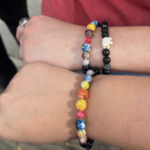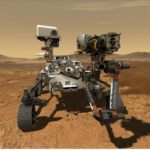Our current list of activities spans from Kindergarten to 6th grade and is constantly growing! All activities are taught with an accompanying presentation that focuses on the science of the topic. Any material necessary is brought by our team.
*The time specified includes the length of the presentation as well as the average time it takes to complete the activity.
| Activity Name | Appropriate Age Range | Description | Photos |
|---|---|---|---|
| Marshmallow Constellations Time: 30 – 45 minutes | K – 3rd | Paired with a presentation on science and mythology of stars, students will make a constellation using marshmallows and toothpicks. |  |
| Design Your Own Constellation Time: 30 – 45 minutes | K – 3rd | Students will have the chance to design their own constellation using a template while learning about the different stories behind the stars. |  |
| Oreo Moon Phases Time: 30 – 45 minutes | 3rd – 5th 5th – 8th | Using oreos, students will represent and understand the different phases of the moon. |  |
| Lunar Phases Demo Time: 30 – 45 minutes | 4th and up | Students will move around a lamp with a moon model to see how the phases of the moon change due to different positions of the moon relative to the Sun. |  |
| How Big is the Sun? Time: 30 – 45 minutes | K – 5th | Students will explore the relative size of the Sun compared to the Earth using stickers and counting. |  |
| Build Your Own Starfinder Time: 1 hour | 4th and up | Paired with a presentation on science and mythology of stars, students will create their own tool to find stars and constellations in the Idaho night sky. (Can be paired with marshmallow constellations activity which would increase the time to 1.5 hours) |  |
| Scale of the Solar System Time: 45 minutes | 2nd – 6th | Students will use different scales (steps for younger students and centimeters for older students) to understand the relative differences between the major objects in the Solar System. Students can use chalk outside to color and label the planets. |  |
| Solar System Scroll Time: 45 minutes | 4th – 8th | Paired with an informative, fun presentation about the Solar System, students will build a Solar System scroll by predicting the scale of our Solar System and the distance between planets, then check their answers using fractions. |  |
| Solar System Bracelets Time: 30 – 45 minutes | K – 8th | After a presentation on the planets in the Solar System, students will create bracelets with beads that represent the planets. |  |
| Stellar Bookmarks Time: 30 – 45 minutes | 3rd – 8th | After a presentation on the various life cycles of stars, students create bookmarks with beads that represent the stages of life for different stars. |  |
| Strawkets Time: 45 minutes – 1 hour | K – 4th | After a presentation on the science of rockets, students will make their own rockets that can be launched with a straw. |  |
| James Webb Space Telescope Brough to Life Time: 1.5 hours | 3rd and up | This fun coloring activity has students work together to draw a portion of an image on a large hexagon, and in the end work as a whole to put the pieces together to form an image from the JWST in the form of its primary mirror. This activity requires 18 groups of 2-4 students. |  |
| Bird Migration Light Pollution Game Time: 30 – 45 minutes | 3rd – 6th | Paired with a presentation about the effects of light pollution, the students play a board game to see how light pollution impacts the natural processes of birds. |  |
| Build a Telescope Time: 30 – 45 minutes | 8th and up | Students in teams of 2 will learn how to build a simple refracting telescope and learn the different types of lenses. |  |
| Coloring Time: 15 – 45 minutes | K – 3rd | Paired with a fun presentation, students will have the opportunity to color fun space related images, create space crowns, and learn basic space disciplines. Feel free to request a specific theme! |  |
| Design Your Own Spacecraft Time: 30 – 45 minutes | 3rd – 6th | Students will learn about the different spacecraft within our own Solar System and then design their own. |  |
| Modeling Solar and Lunar Eclipses Time: 30 – 45 minutes | 3rd – 5th | Students will use play-doh to create models of the Earth and the moon and use the Sun to understand how the positions of the Earth and the moon relative to the Sun cast shadow and cause different eclipses. |  |